Twenty Three Hundred
Functions
Dr Charles Martin
Semester 1, 2022
Week 5: Functions
Outline
because copy-pasting sucks
Function gallery
def plus_1(x):
return x + 1
public String plusOne(int x) {
return x + 1;
}
(define plus-1
(lambda (x)
(+ x 1)))
first, some analogies
Good: pipe (input & output)
or “black box”
Better: there, and back again
$f(a, b) = \int_a^b g(x) \mathrm{d}x$
A function call

talk
Can we do this with branch (b)?
Open questions
- how does the program know where to come back to?
- how do we pass information (i.e., parameters) in?
- how do we get information (i.e., return values) back?
- can we have some “scribble paper”?
note: parameters/arguments - different words for the same thing
Remember Hansel and Gretel?
They try and leave a trail of breadcrumbs behind them so they can find their way back.
bl and bx
bl: branch with link
When the branch with link instruction (bl) is executed, the address of the
next instruction (i.e., the one after the bl instruction) is placed in a
specific register
lr: the “link register”
Just like r15 (pc), r14 also has a special meaning—it’s the link
register
bx: branch and exchange
The lr might contain the address of the instruction we want to go back to, but
how do we actually return there?
The branch and exchange (bx) instruction branches not to a static label, but
to an address in a register
Don't worry too much about the "exchange" part
The “exchange” part means that bx can switch the CPU between “ARM” and “Thumb” execution modes.
We only ever use Thumb mode.
The way this work is tricky. bx rN says “branch to the address located in rN”.
Code address are aligned to half-words, so the lowest bit of the memory address is always zero. This lowest bit is used by bx to change execution mode.
Putting it all together
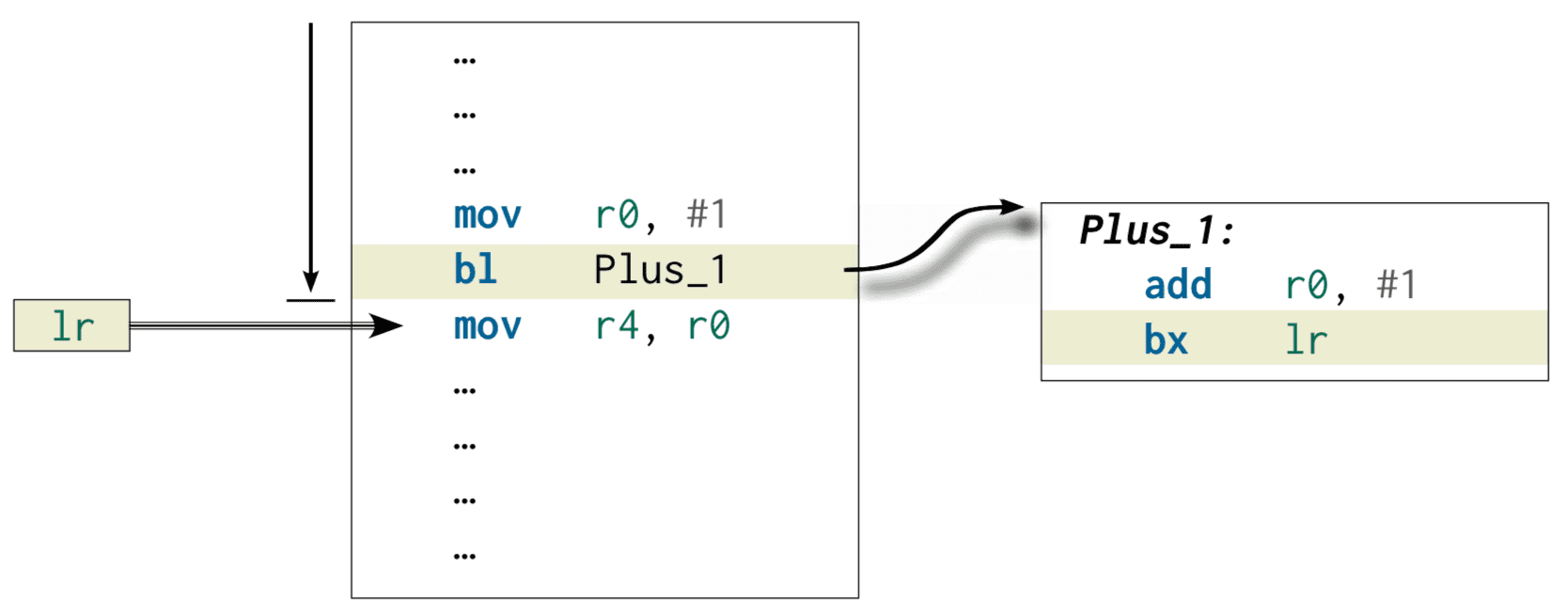
What about conditional branches?
Both of these new branch instructions (bl) and (bx) can’t be used
conditionally (e.g. with an eq suffix) in the ARMv7-M ISA your microbit uses
You can get around this with IT blocks if you want, or you can use regular conditional branch (e.g., bgt)
cmp r0, #8
IT eq
bleq add_one
Function template
@ use the type directive to tell the assembler
@ that fn_name is a function (optional)
.type fn_name, %function
fn_name: @ just a normal label
@
@ the body of the function
@
bx lr @ to go back
Functions are simple
use a bl <label> to branch with link
use a bx lr instruction to come back
Analogy Time: RPG quests
Nested Functions
Nested functions
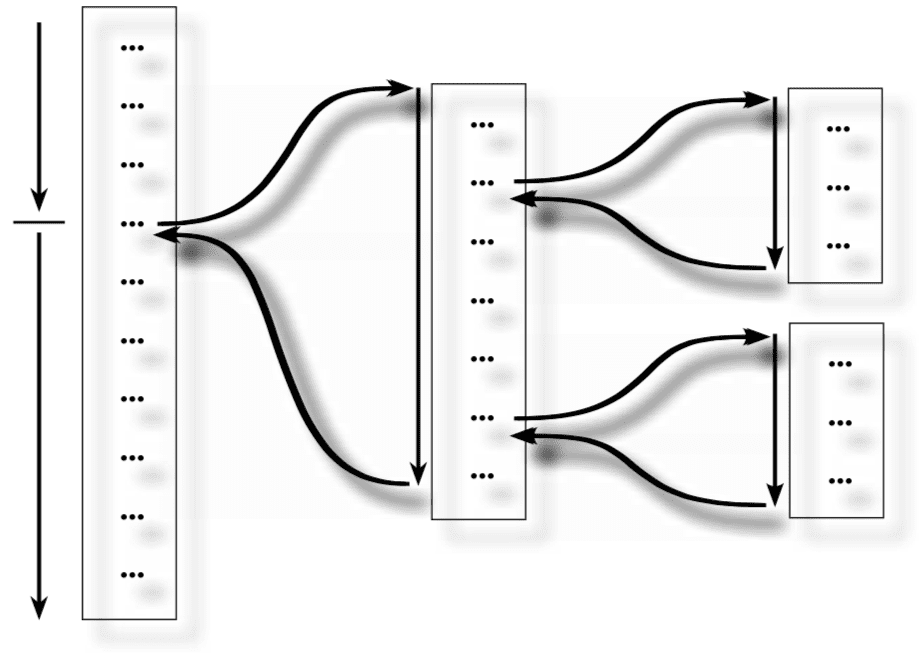
did the breadcrumbs thing work for Hansel & Gretel?
Nested Plus_1 (broken!)

talk
How can we stop the “first” return address getting clobbered?
Sure, store it to memory, but where?
Nested Plus_1 (fixed!)

this will work in this case, but there’s still a slight problem with the use of
sp here—can you spot it?
The stack (sneak peek)
One final new register: the stack pointer (sp, but it’s actually r13)
By convention: the value of the sp is an address in the SRAM region of the
address space (like with the .data section)
basically, it’s memory you can use to get things done
We’ll return to the stack later…
Calling conventions
Open questions
how does the program know where to come back to?- how do we pass information (i.e., parameters) in?
- how do we get information (i.e., return values) back?
- can we have some “scribble paper”?
assume x is in r0…
We need a convention
an agreed-upon plan for where to find the input(s) and where to leave the result
Calling convention definition
This is called a calling convention (CC)
It’s a contract between the caller (the code which makes the function call with
bl <label>) and the callee (the code between <label> and the bx lr
instruction)
What does the CC specify?
- where to look for the parameter values (the inputs)
- where to leave the outputs
- which registers to touch, which to leave alone
talk
Which calling convention does this function use?
int do_all_the_things(int how_many_things){
// lies! does *none* of the things
return 0;
}
trick question!
There are many possible CCs
It doesn’t matter which calling convention you use (as we’ll see), as long as the caller and the callee use the same convention
CC example
Do these two two Plus_1 functions both give the right answer (i.e., x+1)?
What’s the difference?
Plus_1:
add r0, r0, 1
bx lr
Plus_1:
add r5, r2, 1
bx lr
AAPCS
The ARMv7 Architecture Procedure Call Standard is the convention we’ll (try to) adhere to in programming our microbits.
The full standard is quite detailed, but the general summary is:
-
r0-r3are the parameter and scratch registers -
r0-r1are also the result registers -
r4-r11are callee-save registers -
r12-r15are special registers (ip,sp,lr,pc)
What are scratch registers?
r0-r3 are “scratch” registers, which means that the caller can freely use
them (and not worry about messing anything up)
These are also called “caller-save” registers, because if the caller wants to preserve the values in them they need to save them somewhere
Parameters and Return Values
Different ways to get data in/out
Do these two two Plus_1 functions both give the right answer (i.e., x+1)?
What’s the difference?
@ pass by value
Plus_1:
add r0, 1
bx lr
@ pass by reference
Plus_1:
ldr r3, [sp]
add r3, 1
str r3, [sp]
bx lr
Pass-by-value vs pass-by-reference
Two different approaches to passing parameters and return values in and out of a function.
- pass by value makes a “copy” (can mess with it without affecting the caller)
- pass by reference gives the callee access to the same bits as the caller
pros and cons to both, depends on the nature of the things being passed in and out
in general, data needs to live in memory (registers are not for long-term storage)
The stack
Open questions
how does the program know where to come back to?how do we pass information (i.e., parameters) in?how do we get information (i.e., return values) back?- can we have some “scribble paper”?
What about local variables?
function doStuff(a, b){
let c = a+b;
let d = a-b;
let e = a*b;
// function body here
}
maybe put c, d and e in more registers?
What about local variables?
function doArrayStuff(a, b){
let person = {
name: "Esmerelda",
age: 54,
pets: ["rex", "daisy"]
};
let junk = new Array(1000);
// function body here
}
there aren’t enough registers this time
The stack pointer (revisited)
The stack pointer (sp) contains a memory address, and this can be used by
functions for various purposes:
- “saving” values in registers which would otherwise be overwritten (e.g.
lr) - passing parameters/returning values
- temporary variables, e.g. “scribble paper”
It’s called the stack because (in general) it’s used like a first-in-last-out (FILO) stack “data structure” with two main operations: push a value on to the stack, and pop a value off the stack
but only if you follow the rules
Setting up the stack
Look at the first instruction executed in the startup file:
ldr sp, =_estack
Loads a value (_estack) into sp using the ldr
pseudo-instruction
The exact value of _estack comes from the linker file (line 34):
/* Highest address of the user mode stack */
_estack = 0x20018000; /* end of RAM */
Stack pointer in memory
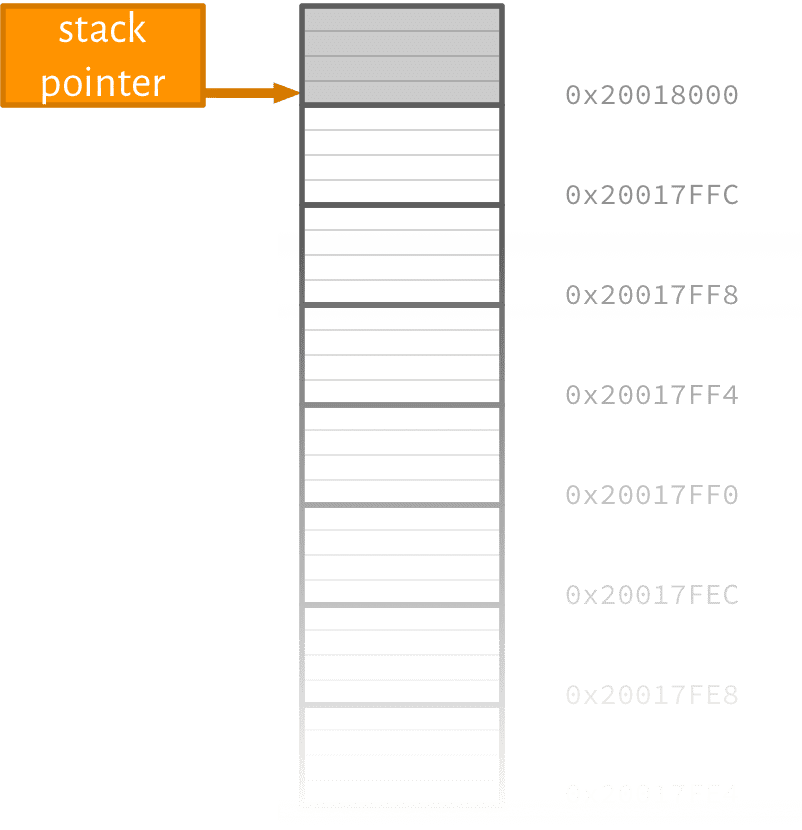
More about the stack pointer
- the value (remember, it’s a memory address) in
spchanges as your program runs -
spcan either point to the last “used” address used (full stack) or the first “unused” one (empty stack) - you (usually) don’t care about the absolute
spaddress, because you use it primarily for offset (or relative) addressing - stack can “grow” up (ascending stack) or down (descending stack)
- in ARM Cortex-M (e.g., your microbit) the convention is to use a full descending stack starting at the highest address in the address space which points to actual RAM
Stack Instructions
Using the stack
Just use sp like any other register containing a memory address:
mov r2, 0xfe
@ push the value in r2 onto the stack
str r2, [sp, -4]
sub sp, sp, 4
@ do some stuff here
@ pop the value from the "top" of the stack into r3
ldr r3, [sp]
add sp, sp, 4
Push, illustrated
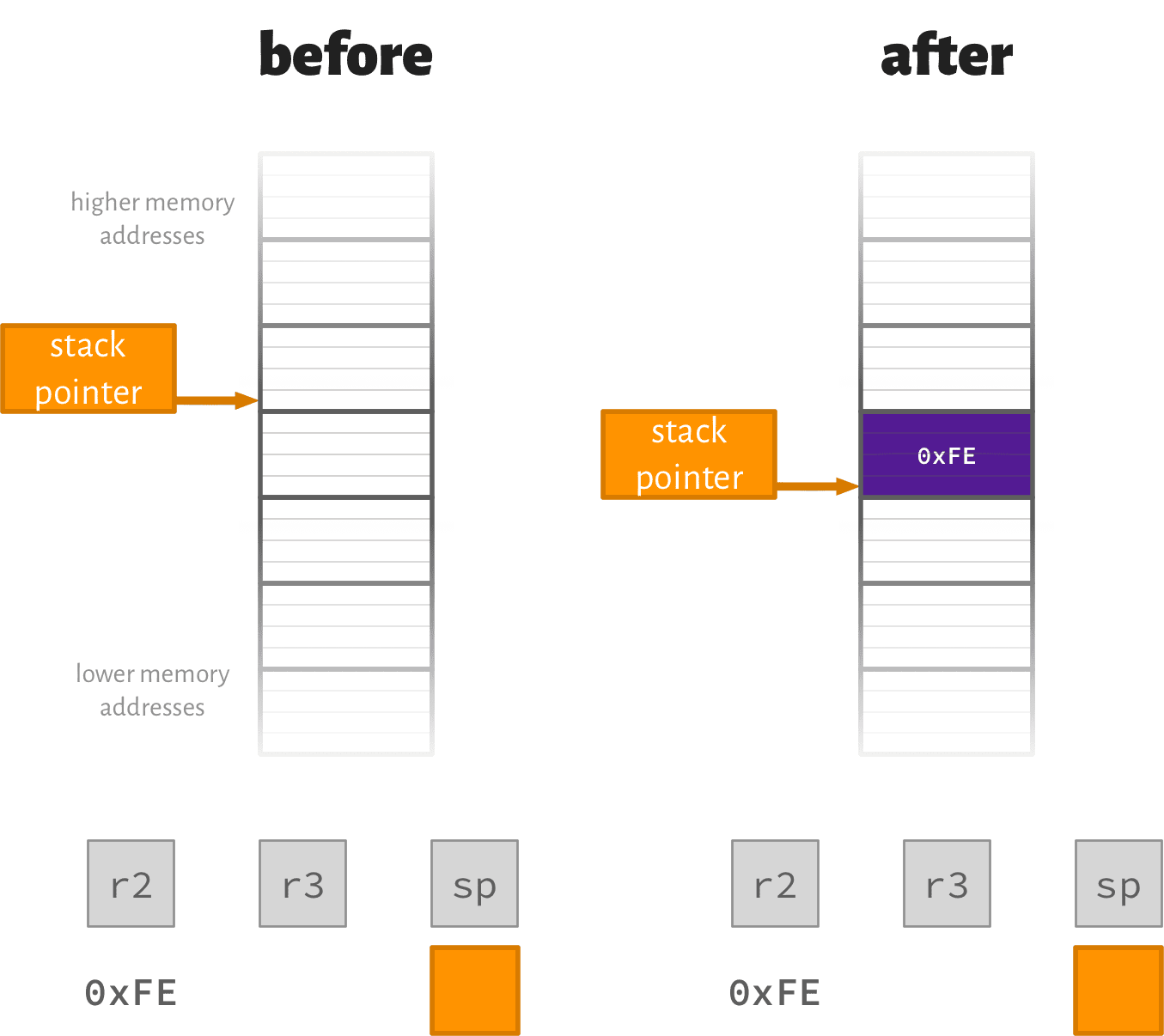
Pop, illustrated
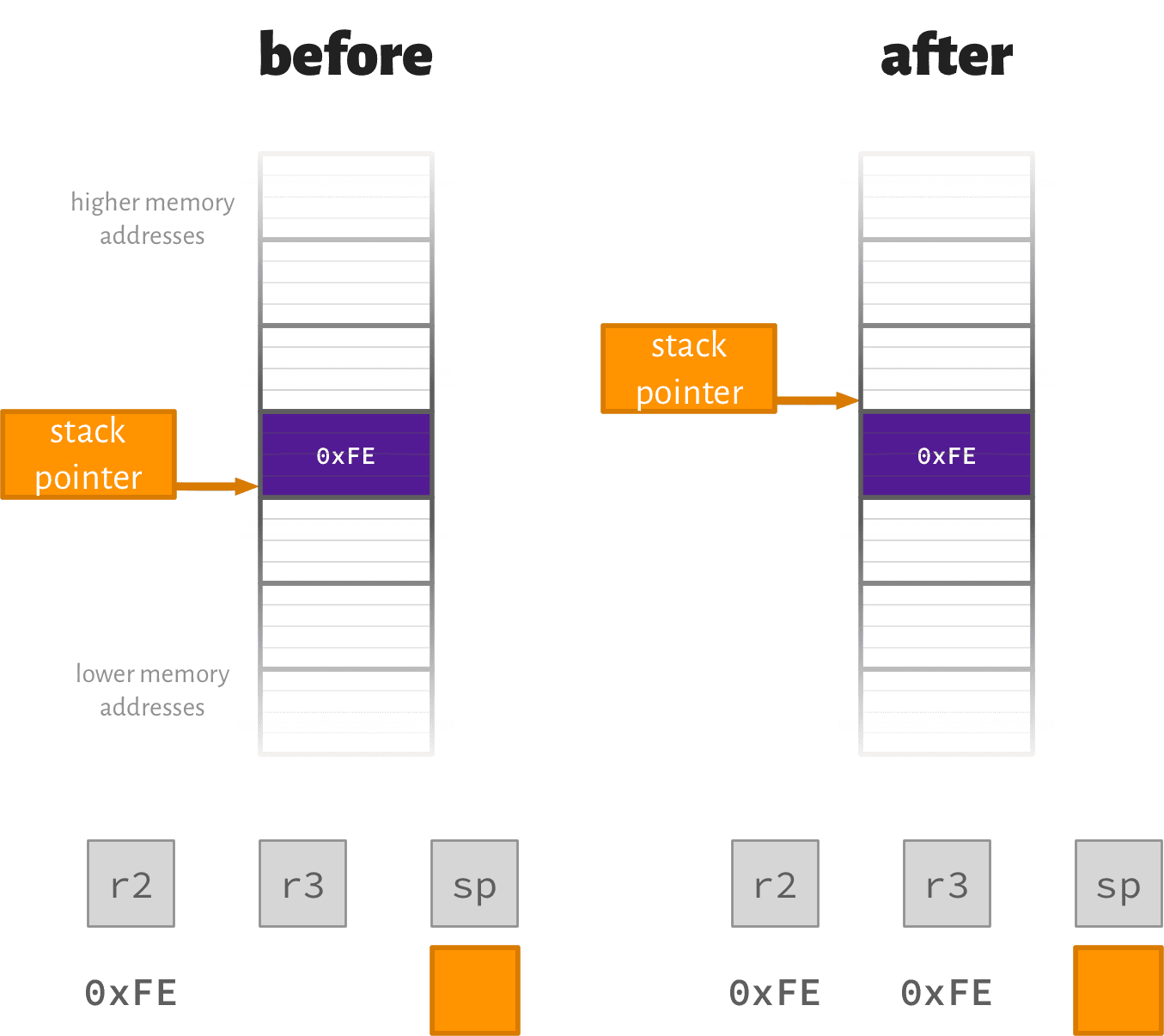
the “missing” values in the diagrams aren’t empty, just unknown
Offset load and store with write-back
ldr/str with offset can write the new address (base + offset) back to the
address register (in this case r1) in two different ways
- pre-offset: update the index register before doing the store (or load)
@ r1 := r1 + 4 str r0, [r1, 4]! @ note the "!" - post-offset: update the index register after doing the load (or store)
@ r1 := r1 - 8 ldr r0, [r1], -8 @ no "!" for post-offset
Pre-offset addressing
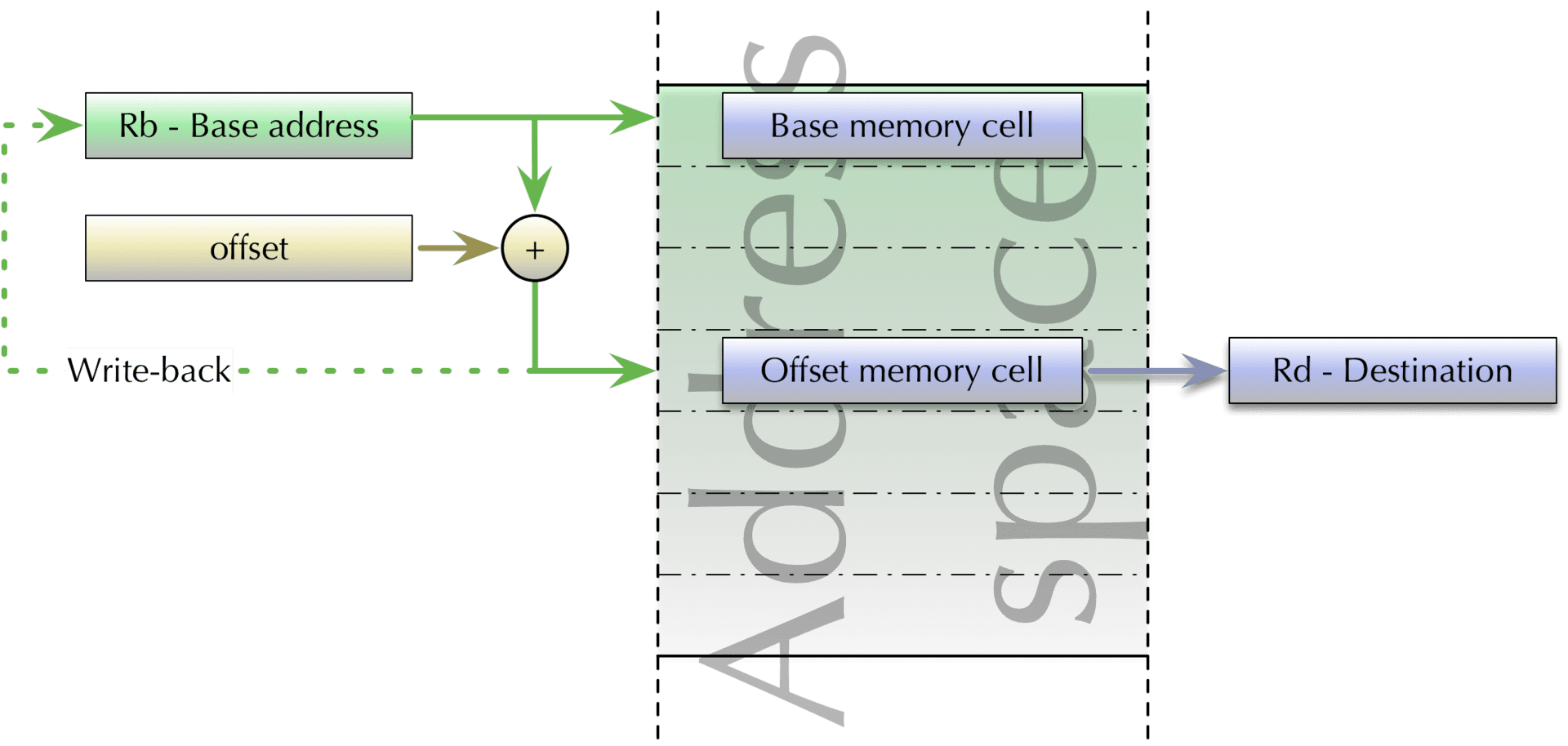
Post-offset addressing
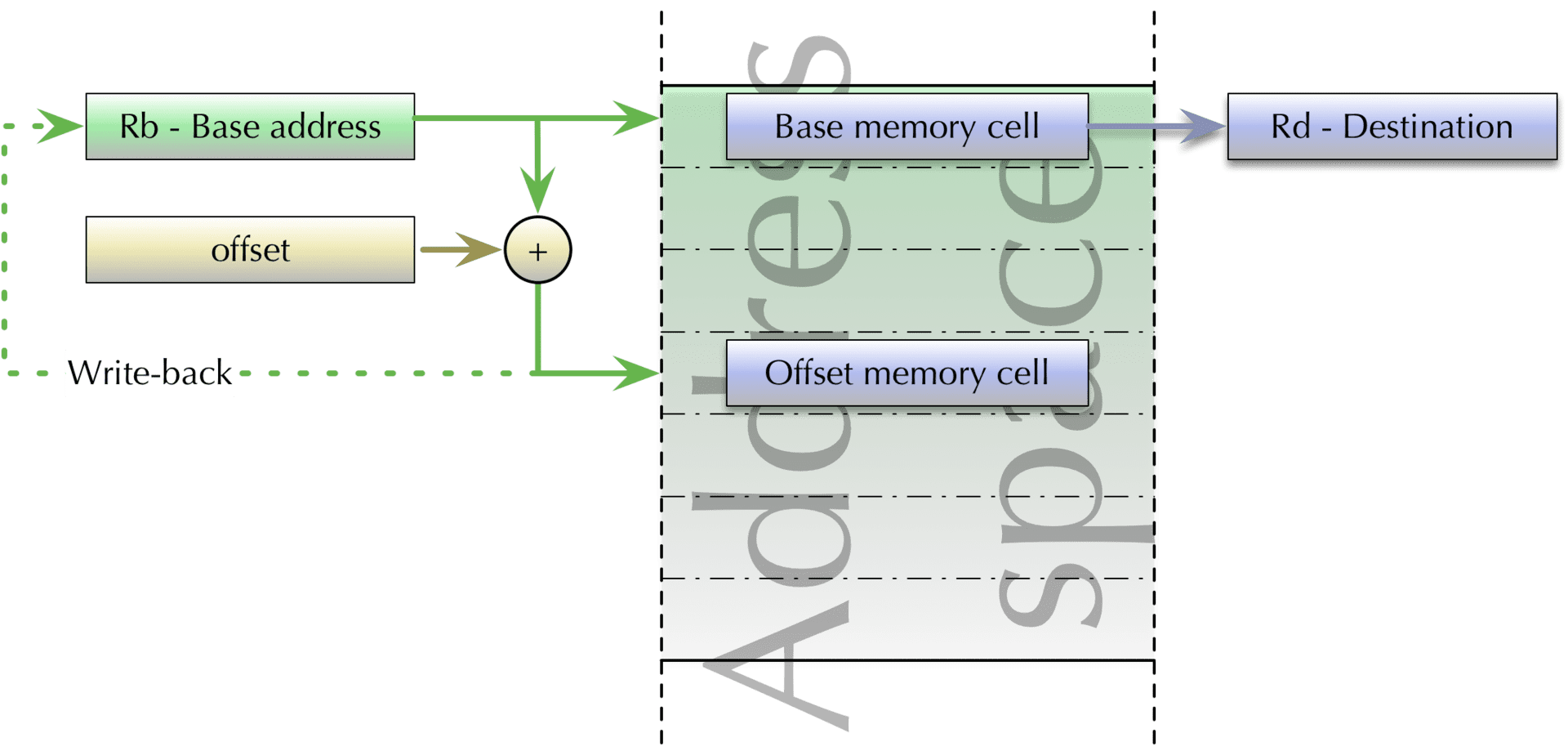
Stack pointer example (again)
Pre/post offset addressing means fewer instructions
mov r2, 0xbc
@ push
str r2, [sp, -4]!
@ do stuff...
@pop
ldr r3, [sp], 4
push and pop instructions
Doing this with the stack pointer (sp) as the base address is so common that
the ISA even has specific push and pop instructions
mov r2, 0xfe
@ gives same result as `str r2, [sp, -4]!`
push {r2}
@ do stuff...
@ gives same result as `ldr r3, [sp], 4`
pop {r3}
note that the sp base address is implicit
Register list syntax
There was one other difference in the push and pop syntax: the brace ({
}) syntax around the register name
Certain instructions take register lists—they can apply to multiple registers at once, e.g.
@ push r0, r1, r2, r9 to stack, decrement sp by 4*4=16
push {r0-r2,r9}
@ pop 4 words from the stack into r0, r1, r2, r9
pop {r0-r2,r9}
push instruction encoding
from A7.7.99 of the reference manual

Load/store multiple
There are also instructions for loading/storing multiple words using any register as the base register
-
ldmdbload multiple, decrement before -
ldmiaload multiple, increment after -
stmdbstore multiple, decrement before -
stmiastore multiple, increment after
But if sp is the base address, then push and pop are probably easier to
read
be careful about the order!
Further reading
http://www.davespace.co.uk/arm/introduction-to-arm/stack.html
Ben Eater - What is a stack and how does it work? (YouTube)
Plantz - Passing Data in Registers
Plantz - The Stack
Functions and Stack Frames
Function prologue & epilogue
The beginning (or prologue) of a function should:
- store (to the stack)
lrand any other values (e.g. parameters) in registers which will clobbered during the execution of the function (remember the AAPCS) - make room for any temporary variables by decreasing the stack pointer
Function prologue & epilogue
The end (or epilogue) of a function should:
- re-increment the stack pointer to free up the room for temporary variables
- restore all the stored values back to the registers (e.g.
lr) - make sure the return value is left in the right place
- restore the stack state (e.g. put the
spback where it was)
Share house kitchen
Function prologue & epilogue example
.type my_func, %function
@ assume three parameters in r0-r2
my_func:
@ prologue
push {r0-r2} @ sp decreases by 12
push {lr} @ sp decreases by 4
@ body: do stuff, leave "return value" in r3
@ epilogue
mov r0, r3 @ leave return value in the right place
pop {lr} @ sp increases by 4
add sp, sp, 12 @ balance out the initial "push"
bx lr
Function stack frame
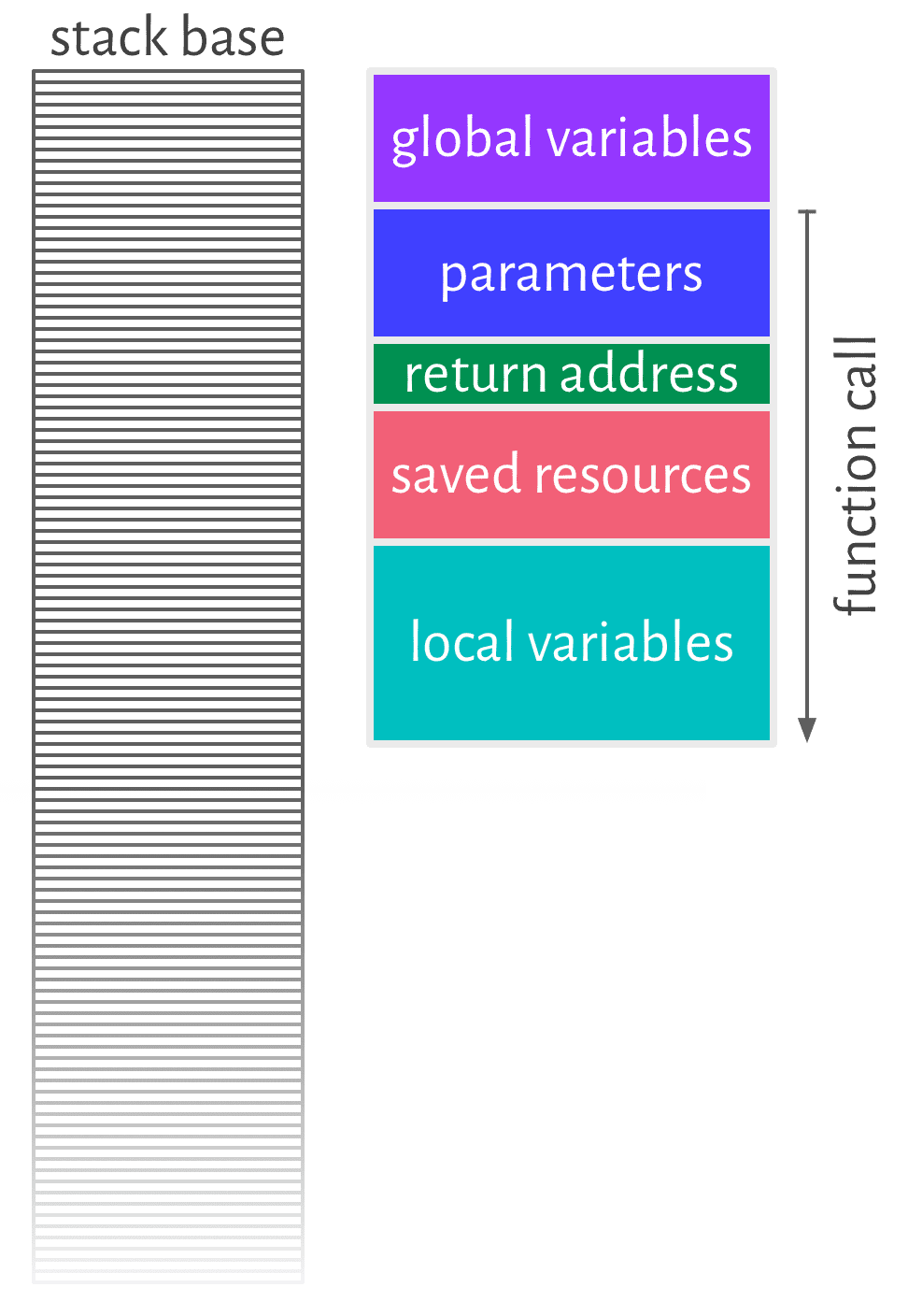
Nested function calls
outer_fn:
push {r0,lr}
bl middle_fn
pop {r0,lr}
bx lr
middle_fn:
push {r0,lr}
bl inner_fn
pop {r0,lr}
bx lr
inner_fn:
@ do inner function stuff
bx lr
Nested stack frames

the sp “zippers” up and down as the program executes
There’s lots more to say…
- there’s more you can put in your stack frame (e.g. frame pointer
fp) - ARMv7/AAPCS is pretty register-heavy (other ISA/CCs use the stack more, e.g. for parameter passing and return addresses)
- an optimizing compiler will almost certainly not generate the code you expect
- recursion is an interesting case (wait till lab 7)
These are all conventions
It’s the programmer’s job to adhere to them: the operating systems programmer, the compiler programmer, the library programmer, the application programmer, …
For bare-metal assembly programming, you’re all of those